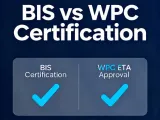For anyone wanting to produce or distribute a medical device in India, knowledge of CDSCO medical device registration is absolutely essential. The CDSCO is in charge of examining medical devices and guaranteeing their quality and safety in India. Its primary duty is to make sure that every medical device sold or offered in the nation meets the necessary safety, efficacy, and quality standards. This blog will explain the CDSCO guidance and the medical device registration process in India.
Table of Contents
What Is CDSCO?
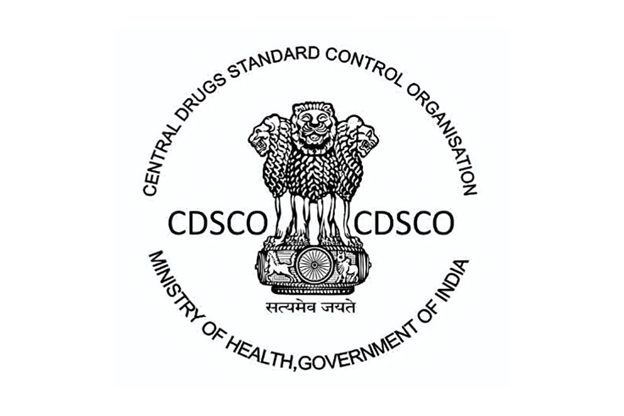
Under the Ministry of Health and Family Welfare, the Central Drugs Standard Control Organisation is the country's authority in India that regulates medications and medical devices. CDSCO guarantees that only safe, tested, and approved devices are allowed in the market.
If listed under the official categories, all devices, whether made in India or brought from elsewhere, must go through the CDSCO medical device registration procedure.
Why Is CDSCO Registration Important?
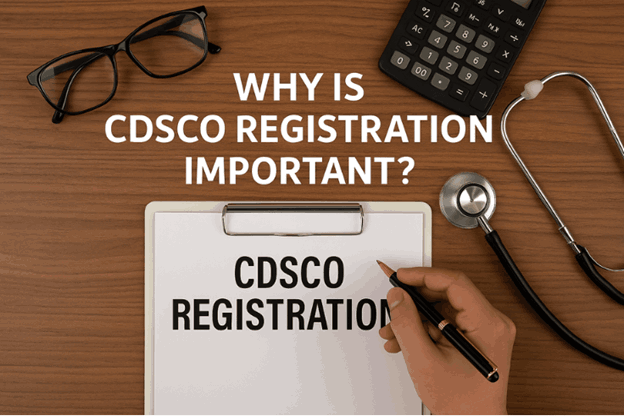
Registering confirms your medical equipment is market-ready and safe. You cannot legally sell or operate the gadget in India without this step. Following the guidelines also fosters patient and hospital or clinic confidence.
The Indian medical device market is growing fast. You have to make sure your device is CDSCO-registered if you wish to join in it. Correct registration demonstrates your devotion to legal compliance, quality, and safety.
CDSCO Registration Checklist
Here is a step-by-step CDSCO registration checklist that will help you apply the right way:
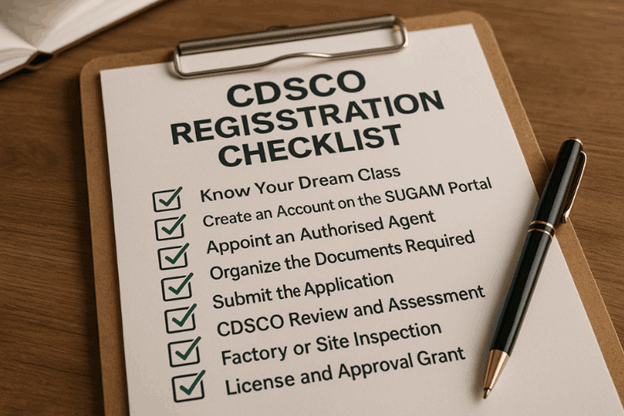
1. Know Your Dream Class
The first step is to know how your product is classified:
- Class A: Low risk (tongue depressors, thermometers)
- Class B: Low to medium risk (hypodermic needles)
- Class C: Medium to high risk (heart valves)
- Class D: High risk (pacemakers, ventilators)
Each class has its own level of review. Class A and B devices have easier requirements. Classes D and C go under stricter verification.
2. Create an Account on the SUGAM Portal
SUGAM is the online portal for CDSCO services. You first need to get yourself registered as a manufacturer, an importer, or an agent. You will upload all forms and documents here.
3. Appoint an Authorised Agent (in case of import)
In case the equipment is produced outside India, the manufacturer is obliged to appoint an Indian company or person as an “authorized agent.” This agent must hold a valid wholesale license and represent the manufacturer for CDSCO purposes.
4. Organize the Documents Required
This is probably the most crucial part of the process. You will require:
- Application form (MD 14 or MD 15 based on the class)
- Cover letter compiling your application
- Device Master File (DMF)
- Plant Master File (PMF)
- Test reports and validation records
- Risk and safety information
- Clinical evaluation (for Class C/D)
- Free sale Certificate (country of origin)
- Label and package information
- Declaration of conformity
- Information of the Indian authorized agent (imported)
- Payment receipt
All the documents should be clear and accurate for the medical device registration process in India. If something is not complete, your application can be refused or delayed.
5. Submit the Application
Once prepared, submit the application via the SUGAM portal. Ensure that once you upload each document in the appropriate section, you follow the naming convention. Pay the fee online.
6. CDSCO Review and Assessment
Your application will be examined now by CDSCO officials.
Classes A and B have faster reviews, and physical inspection might not be required.
For classes C and D, the technical examination can be done by the experts or by visiting the factory.
7. Factory or Site Inspection (if needed)
CDSCO is entitled to inspect your factory, especially for devices in Classes D and C. They will certify that your facility meets Good Manufacturing Practices (GMP) and safety standards.
8. License and Approval Grant
Assuming all goes well, you will be given your CDSCO medical device registration India certificate. This means your product is now legally permitted in India.
The License is valid for five years from the date of application. Store it safely, be aware that it has expired, and renew it in a timely manner.
Post-Approval Rule to Observe
After you’ve gained approval, you need to:
- Report to CDSCO in case of any changes in the device or packaging
- Submit safety reports in case of post-sales problems arising
- Maintain records in detail
- Mark the product as per the CDSCO regulations
- Renew the license every 5 years
These are medical device regulations for medical device registration India, which prevent future issues.
Medical Device Voluntary Registration India
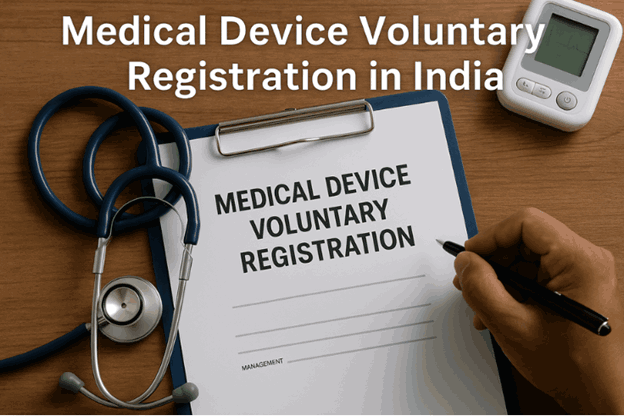
A few of these medical devices in India are not at high risk and do not require present registration under the CDSCO rules. It mainly comprises unsterilized and measurement-free goods classified under Class A. For example, simple tools or devices can be used at home or in clinics.
CDSCO does, however, allow companies to continue the medical device voluntary registration India. You can opt to register even though it is not yet mandatory under the law.
Why Voluntary Registration is a Good Idea
- Be Ahead of the Law: Laws tend to change. Something that is voluntary today may become mandatory tomorrow. By pre-registering, your business remains in control and avoids future hassles.
- Establish Consumer Confidence: Hospitals, clinics, and buyers prefer to purchase a registered device. Voluntary registration gives your product an assurance of being safe, even when it is not legally necessary yet.
- Improved Brand Perception: It indicates that your organization is concerned about quality and patient safety. Belief in your brand will improve and make it a standard in the market.
- More Chances in Exports: In case the device is listed in India, it will facilitate easy access to clearances overseas.
So, although it may not be compulsory for all products, voluntary registration of Indian medical devices is an ethical and prudent move for all companies that want to produce and build credibility.
CDSCO Medical Device Manufacturing License
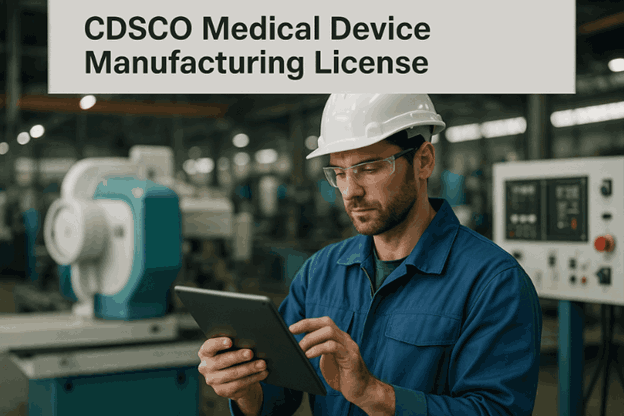
It is mandatory to get a CDSCO medical device manufacturing license to produce medical devices in India. It is not the same as registration. It ensures that your factory meets the clean and safe standards of manufacturing.
For this, submit using Form MD-3 or MD-7 and enclose:
- List of equipment
- Quality documents
- Staff documents
- Equipment list
Your premises will also be inspected prior to approval.
Benefits of Being a CDSCO-registered Medical Device

1. Legal Sale in the Indian Market
After your device is registered with CDSCO, you can sell it anywhere within India. Your device cannot be sold or utilised in hospitals or clinics legally unless it is registered.
2. Build Trust with Doctors and Hospitals
Doctors, nurses, and hospitals trust registered products more because they have faith that these devices will abide by the safety and quality measures of the Indian government.
3. Makes Global Approvals in the Future Easier
If your device has previously been approved in India, approvals in other places become more reachable. Registration indicates that your product is of high quality.
4. Safeguards Patients
Tested and reviewed devices are registered. This eliminates side effects or negative results. It ensures that patients who are using your product are not put in harm’s way.
5. Reduces the Chances of Legal Penalties
If you are shipping an unregistered medical device, you will be fined, or your product will be banned. Using CDSCO registered medical device saves you from legal issues.
Common Mistakes to Avoid

1. Not Checking Device Classification
Every device comes under Class A, B, C, or D. If you select the wrong class, your entire application may get rejected or held up. Always verify your device's class prior to applying.
2. Choosing the Wrong Form
Various classes require different types. Required forms for specific courses:
- MD 14 form: For Class B and Class A.
- MD 15 form: For Class D and Class C.
Choosing the wrong form is a frequent mistake.
3. Missing Documents
Your application will not proceed even if one missing document is required. Verify the list of documents before submitting.
4. Skipping Payment or Uploading a Poor Quality Challan Image
You have to pay a registration fee. If you do not pay or submit a poor-quality challan (receipt of payment), your application can be delayed or rejected.
5. Non-renewal Within Due Time
CDSCO registration has a 5-year validation period. If you do not renew it before it expires, you lose the right to sell the device and must start over.
Final Words
Your CDSCO medical device registration is a must to do if you want to enter the Indian market legally and safely. This manual will help you with the procedure, whether you are a local producer or a multinational company. Consider this CDSCO registration checklist to make sure you are on the right track and making no mistakes.
With proper planning and documentation, obtaining your device approval is simple. If you intend to retail products within India, don’t overlook applying for the CDSCO medical device manufacturing license. Company adherence is a business intelligence decision on behalf of your company and your consumers.






